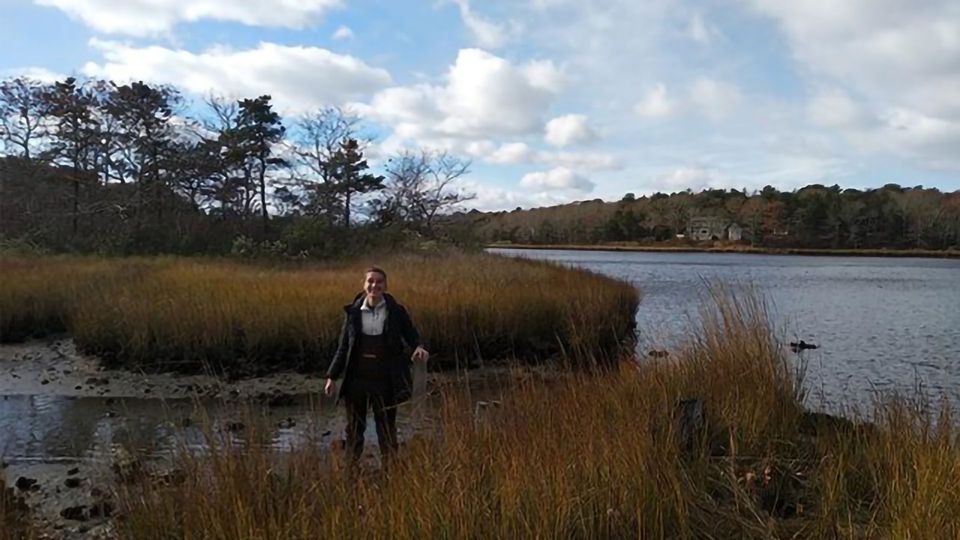Record of Human Plastic Use Trapped in Salt Marshes

Complete the form below to unlock access to ALL audio articles.
Plastics are everywhere. From cell phones to pens and cars to medical devices, the modern world is full of plastic-- and plastic waste. New research from scientists at the Marine Biological Laboratory (MBL) Ecosystems Center found that some of that plastic waste has been accumulating in salt marshes for decades. The study was published in Environmental Advances.
Salt marshes are the link between the land and open ocean ecosystems, and -- in a way --between urban environments and the wild ocean. Microplastics (plastic particles smaller than 5 millimeters) tend to float on the water surface, but salt marshes fill and empty with the tides, so particles that would normally float get trapped within branches and roots and settle into the marsh soil.
Sediments accumulate in the salt marsh layer after layer, like tree rings, keeping an historical record of sedimentation within the ecosystem. "By accumulating sediments, they are keeping a record in time," says Javier Lloret, MBL research scientist and co-first author on the paper.
Globally, scientists estimate that about 8 million tons of plastic enter the ocean each year. But until now, there's been no estimation of the amount of that plastic that gets trapped in salt marsh ecosystems.
By taking core samples of the marsh sediment at six different estuaries in the Waquoit Bay system on Cape Cod, as well as New Bedford, Mass., harbor, the researchers were able to trace the abundance of microplastics dating back decades in areas with very contrasted degrees of land use.
"As you go into the past, the amount of microplastics you find decreases clearly," says Lloret. "The amount of microplastics you find in sediments is related to the population numbers... but also the amount of plastic that people use."
"Waquoit Bay is the perfect salt marsh system to study plastic pollution because we can contrast one area that is almost pristine... with another area that is highly impacted by human activity," says Rut Pedrosa-Pàmies, also an MBL research scientist and co-first author on the paper. "We found a broad range of plastic pollution."
The researchers focused on two types of microplastic pollution: fragments (from the breakdown of larger plastic pieces) and fibers (thread-like plastics which tend to shed from clothing and fishing gear). They found that fragment pollution increased both through time and with urbanization. The more populated the area surrounding the collection site, the more plastic fragments the researchers observed.
One surprise in the data was that microplastic concentration in the sediments wasn't linear as urbanization grew. Up to 50% development, the concentration of microplastic fragments was relatively unchanged, but once the land was occupied at 50%, the number of microplastics grew exponentially.
"Just a few people in the surrounding area is not going to change much, but when urban uses occupy more than 50% of the land, the number of microplastics goes crazy," says Lloret.
The microplastic fibers didn't have the same relationship with urbanization. "Even in the more pristine areas that don't have urbanization, we find fiber plastic pollution" says Pedrosa-Pàmies.
The researchers believe the fragments have a local origin (people using and disposing of plastics where they live) whereas fibers can be transported long distances by air or by water from large-scale urban areas.
"When we started, we didn't know if microplastics were an issue here on Cape Cod, or not. No one had analyzed the marsh sediments on Cape Cod for microplastics before," says Lloret.
Now that the scientists have shown there is microplastic pollution in New England salt marshes, the next step is to gain further insight. How are those particles arriving in the ecosystem? What are the sources? How are they impacting the ecosystem and the food web of the organisms that live there?
"There are still a lot of unanswered questions," says Pedrosa-Pàmies. "This is the first step for management, too."
Reference: Lloret J, Pedrosa-Pamies R, Vandal N, et al. Salt marsh sediments act as sinks for microplastics and reveal effects of current and historical land use changes. Environ Adv. 2021;4:100060. doi: 10.1016/j.envadv.2021.100060
This article has been republished from the following materials. Note: material may have been edited for length and content. For further information, please contact the cited source.



